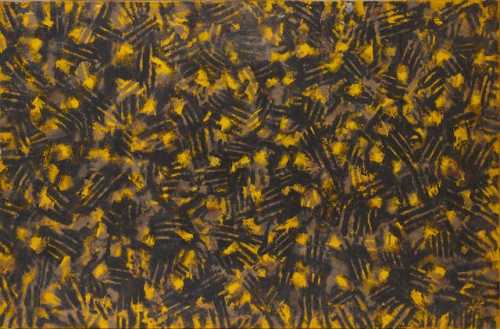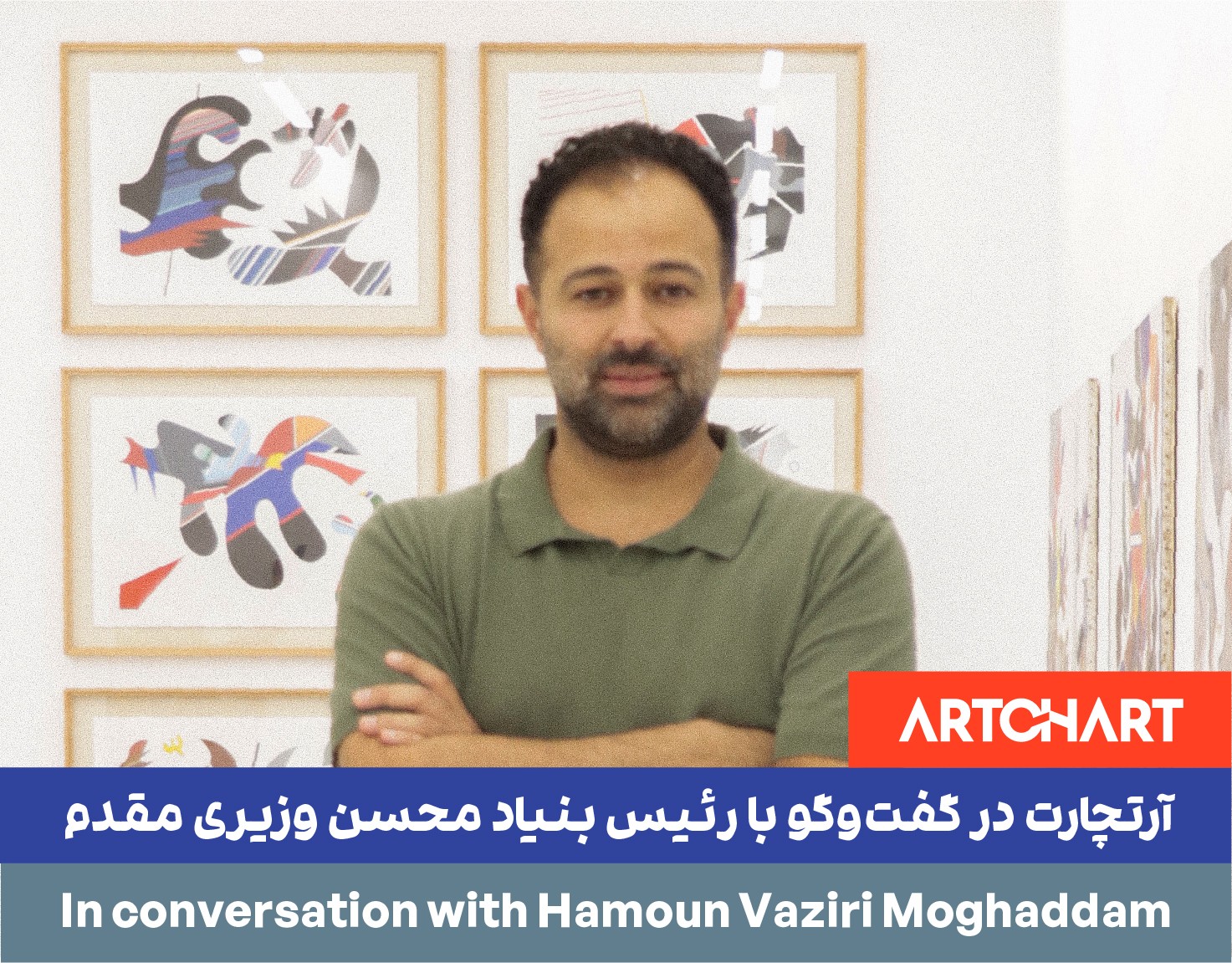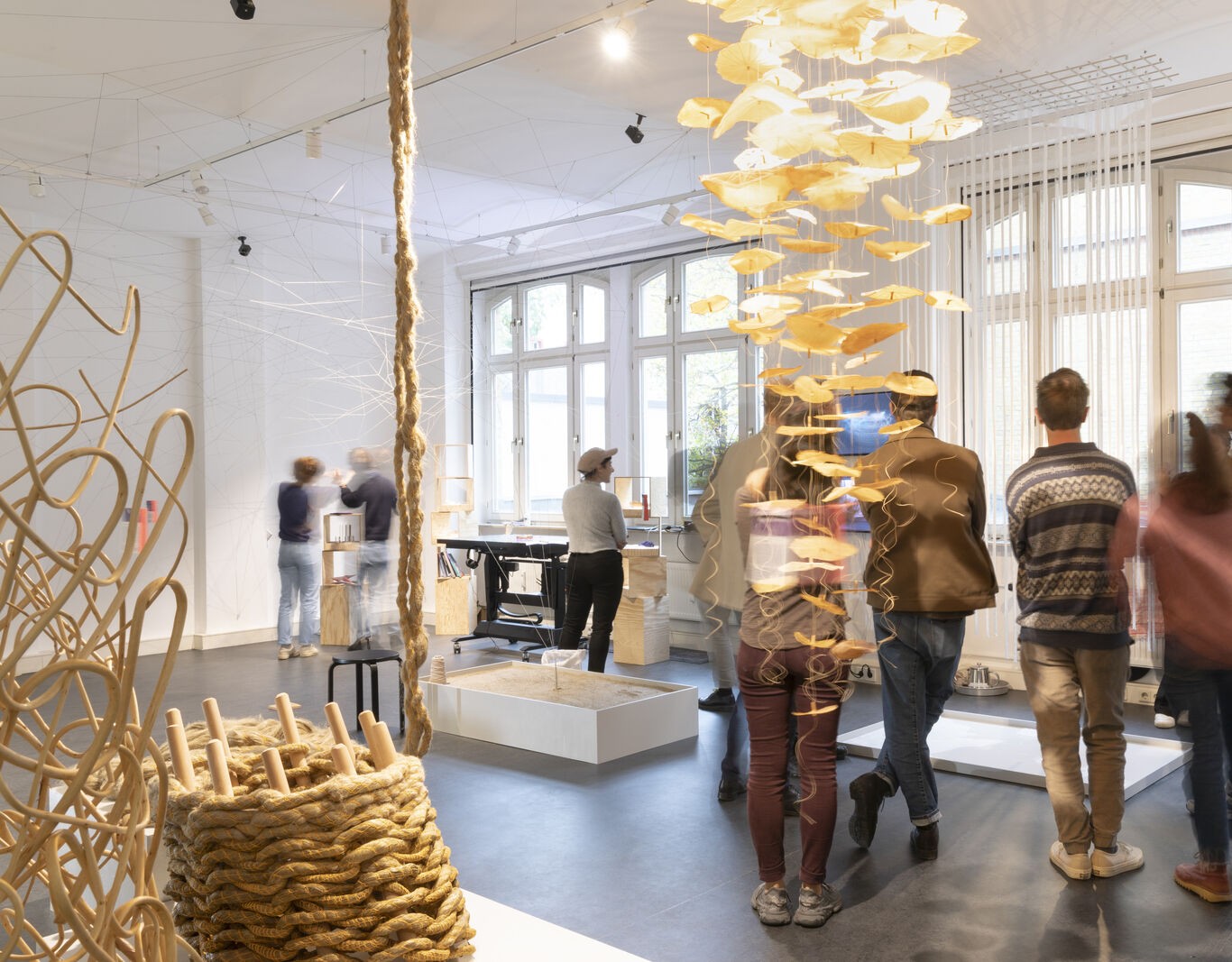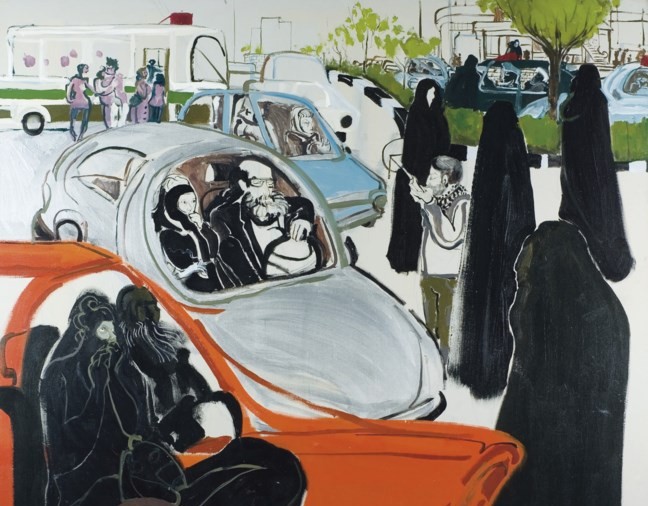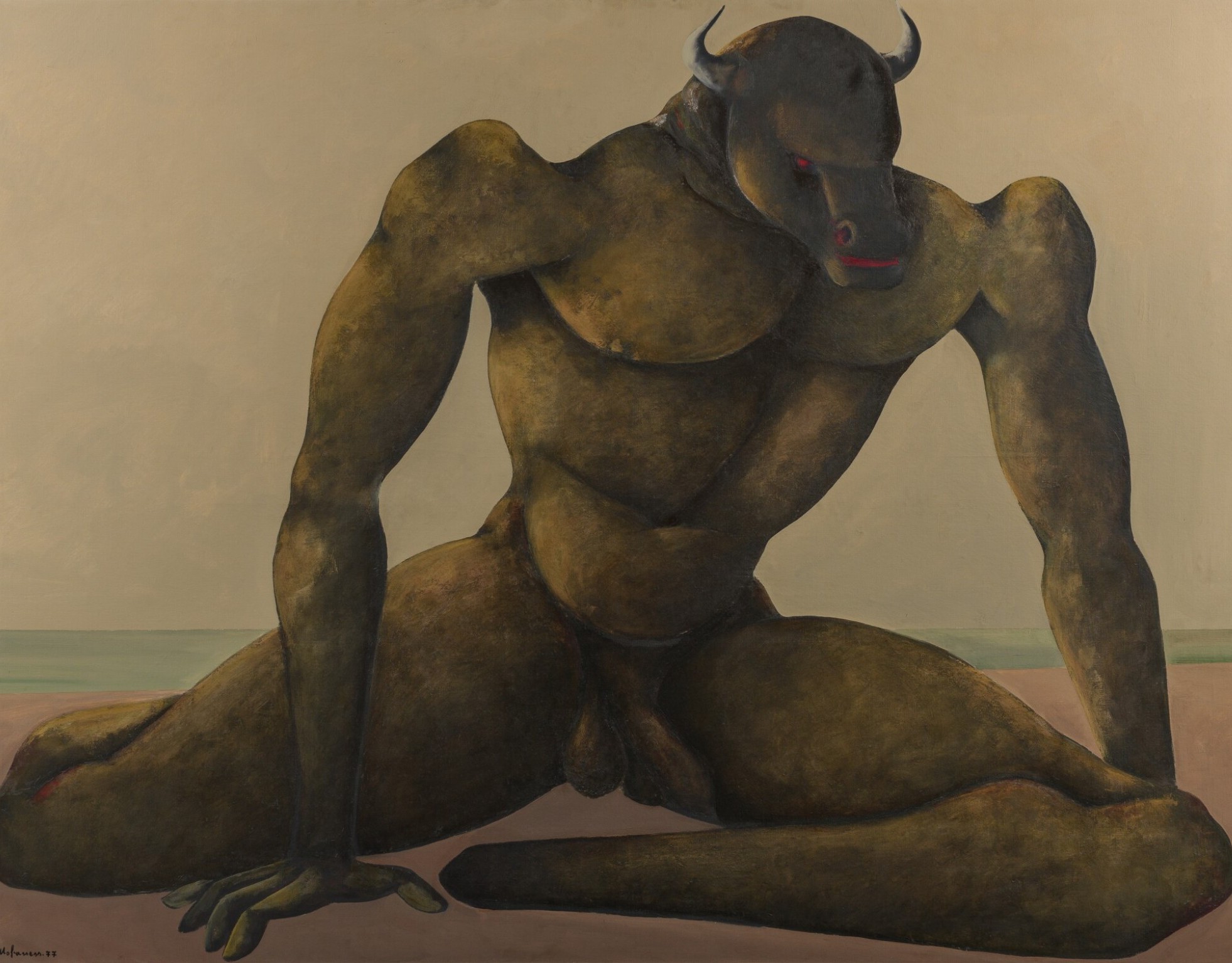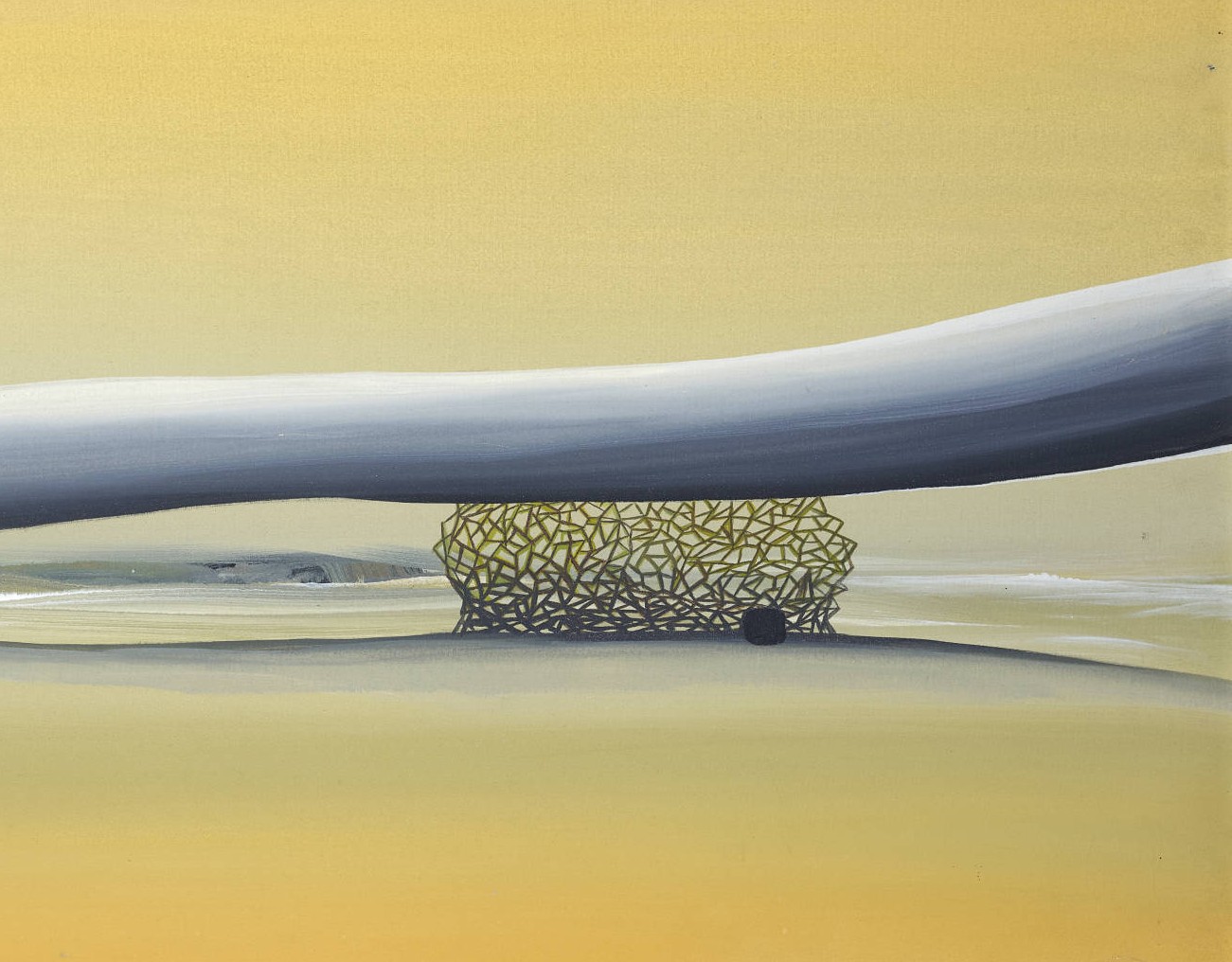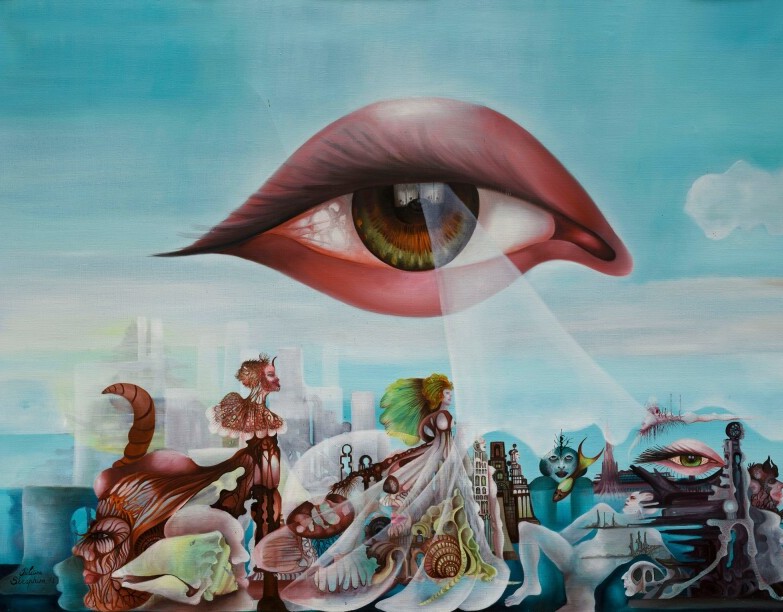About Mohsen Vaziri Moghaddam
Mohsen Vaziri Moghaddam was an influential Iranian modernist painter and sculptor who remained active and exhibited his work until the final years of his life. He began experimenting with oil painting at the age of 16 and pursued formal art education despite financial difficulties during his studies.
His first solo exhibition was held in 1952 at the Iran-US Association. In 1955, he traveled to Italy to study at the Academy of Fine Arts in Rome, where he developed his distinctive style. After returning to Iran, he taught at the Faculty of Fine Arts at the University of Tehran from 1969 to 1976. He spent his later years in Italy, where he passed away.
Mohsen Vaziri Moghaddam was a leading figure among the second generation of modern Iranian painters. He created numerous works in a modernist style and dedicated himself to teaching this approach to future generations. By employing innovative and unique methods, he introduced new perspectives to modern art in Iran. For example, his collection of paintings using black sand on wood and canvas established a new style in Iranian art, marked by his signature. This modern viewpoint was also evident in his large wooden sculptures with dynamic forms.
Vaziri Moghaddam strongly believed in the importance of academic art education. He once stated, "Students learn very little in art schools. Art needs to be taught, not just discussed. It’s not enough to talk about mysticism or play music and then tell students to paint their feelings. Proper instruction in art movements and styles is essential, along with opportunities for field research. A conducive environment and appropriate space are crucial for learning."
Through his dedication to modernist principles and innovative techniques, Mohsen Vaziri Moghaddam significantly impacted Iranian art and inspired future generations of artists.
His first solo exhibition was held in 1952 at the Iran-US Association. In 1955, he traveled to Italy to study at the Academy of Fine Arts in Rome, where he developed his distinctive style. After returning to Iran, he taught at the Faculty of Fine Arts at the University of Tehran from 1969 to 1976. He spent his later years in Italy, where he passed away.
Mohsen Vaziri Moghaddam was a leading figure among the second generation of modern Iranian painters. He created numerous works in a modernist style and dedicated himself to teaching this approach to future generations. By employing innovative and unique methods, he introduced new perspectives to modern art in Iran. For example, his collection of paintings using black sand on wood and canvas established a new style in Iranian art, marked by his signature. This modern viewpoint was also evident in his large wooden sculptures with dynamic forms.
Vaziri Moghaddam strongly believed in the importance of academic art education. He once stated, "Students learn very little in art schools. Art needs to be taught, not just discussed. It’s not enough to talk about mysticism or play music and then tell students to paint their feelings. Proper instruction in art movements and styles is essential, along with opportunities for field research. A conducive environment and appropriate space are crucial for learning."
Through his dedication to modernist principles and innovative techniques, Mohsen Vaziri Moghaddam significantly impacted Iranian art and inspired future generations of artists.
The Most Expensive Artwork
At Auctions
First Attendance
23 February 2005
# Attendance
56
# Artworks
78
Average Realized Price
32,772 USD
Average Min Estimate
23,344 USD
Average Max Estimate
32,657 USD
Sell-through Rate
75.325%
Average Growth of Artwork Worth
35.142%
Timeline
CHARSOO- Part 2 exhibition
3 October
Charsoo exhibition
5 September
Recovery/ The Seventh Series exhibition
13 June
Transparency exhibition
16 May
Shadow exhibition
18 April
The 22nd Tehran - Modern, Classic and Traditional Iranian Art auction
14 February
Landscape Plateau exhibition
13 December
Mohsen Vaziri Moghaddam "100 Years" exhibition
18 October
Mohsen Vaziri Moghaddam "100 Years" exhibition
4 October
Modern & Contemporary African and Middle Eastern Art auction
26 September
Mohsen Vaziri Moghaddam "100 Years" exhibition
20 September
Mohsen Vaziri Moghaddam "100 Years" exhibition
30 August
Mohsen Vaziri Moghaddam "100 Years" exhibition
30 August
Mohsen Vaziri Moghaddam "100 Years" exhibition
30 August
Mohsen Vaziri Moghaddam "100 Years" exhibition
23 August
Mohsen Vaziri Moghaddam "100 Years" exhibition
23 August
Mohsen Vaziri Moghaddam "100 Years" exhibition
16 August
Resize exhibition
16 August
Decades Projects 1300-1310 exhibition
2 August
Mohsen Vaziri Moghaddam "100 Years" exhibition
26 July
Mohsen Vaziri Moghaddam "100 Years" exhibition
25 July
Mohsen Vaziri Moghaddam "100 Years" exhibition
19 July
Mohsen Vaziri Moghaddam "100 Years" exhibition
19 July
Mohsen Vaziri Moghaddam "100 Years" exhibition
19 July
Mohsen Vaziri Moghaddam "100 Years" exhibition
19 July
Mohsen Vaziri Moghaddam "100 Years" exhibition
19 July
Mohsen Vaziri Moghaddam "100 Years" exhibition
19 July
Mohsen Vaziri Moghaddam "100 Years" exhibition
19 July
Mohsen Vaziri Moghaddam "100 Years" exhibition
19 July
Mohsen Vaziri Moghaddam "100 Years" exhibition
19 July
Mohsen Vaziri Moghaddam "100 Years" exhibition
19 July
Mohsen Vaziri Moghaddam "100 Years" exhibition
19 July
The 20th Tehran- Modern and Contemporary Iranian Art auction
5 July
A Collection exhibition
10 May
The 19th Tehran -Classic and Modern Iranian Art auction
24 January
Modern Collectore exhibition
19 January
Prospect 3 exhibition
22 September
The 17th Tehran Modern and Contemporary Iranian Art auction
18 July
Root exhibition
9 June
Modern and Contemporary Middle Eastern Art auction
24 May
Intersect 01 exhibition
19 May
20th Century Art / Middle East auction
27 April
Recovery/ The third series exhibition
10 March
Middle Eastern Modern and Contemporary Part II auction
20 December
Middle Eastern Modern and Contemporary Part I auction
19 December
Modern, Post War and Contemporary auction
30 November
Modern and Contemporary Middle Eastern Art Including Baghdadiyat - Part III auction
23 November
20th Century Art - Middle East auction
25 October
MIDDLE EAST MODERN & CONTEMPORARY auction
5 July
Post War and Contemporary Art auction
9 June
20th Century Art / Middle East auction
23 March
Point Of View exhibition
25 February
Soft Edge of the Blade exhibition
10 February
Marriage and a review of the works of Mohsen Vaziri Moghaddam exhibition
20 January
The 15th Tehran- Modern Iranian Art auction
14 January
Unrealised Projects exhibition
26 November
The Mana Jalalian Collection: A Rare Collection of Iranian Modern Art exhibition
15 November
An overview of Mohsen Vaziri Moghaddam’s Works exhibition
22 October
20th Century Art / Middle East auction
20 October
8th Collector exhibition
9 July
The Collection of Liam Gallery exhibition
20 May
Contemporary Curated auction
6 April
20th Century Art / Middle East auction
23 March
The 13th Tehran- Modern and Contemporary Iranian Art auction
15 January
POST WAR & CONTEMPORARY ART auction
2 December
No.3 auction
23 April
Connoisseur's Look exhibition
12 July
یازدهمین دوره حراج تهران auction
5 July
Installation Exhibition exhibition
2 March
Abstract and Contemporary Art auction
12 December
Modern and Contemporary Middle Eastern Art auction
24 October
The 9th Tehran- Classic and Modern Iranian Art auction
29 June
Geometric Reliefs exhibition
22 June
Boundless: Dubai auction
13 November
Single Artwork exhibition
13 October
The First exhibition
1 September
هفتمین دوره حراج تهران auction
7 July
Modern and Contemporary Middle Eastern Art auction
26 April
پنجمین دوره حراج تهران auction
27 May
Retrospective and Book Launch exhibition
6 November
چهارمین دوره حراج تهران auction
29 May
Intuition of Color exhibition
21 November
Mohsen Vaziri Moghadam Yesterday, Today exhibition
7 November
Islamic and Indian Art auction
7 October
سومین دوره حراج تهران auction
30 May
Art moderne - Art contemporain auction
14 December
Contemporary Art auction
29 October
Fine American and European Paintings, Drawings Prints and Sculpture auction
24 October
دومین دوره حراج تهران auction
28 May
1Ere Vente a Dubai International Modern And Contemporary Art auction
22 October
اولین دوره حراج تهران auction
22 May
Fine American and European Paintings, Drawings, Sculpture and Prints auction
26 April
Modern and Contemporary Arab, Iranian and Turkish Art Part II auction
18 April
Fine American and European Paintings, Drawings Prints and Sculpture auction
28 October
Fine American & European Paintings auction
29 April
Auction 23 - Day One auction
17 March
International Modern & Contemporary Art auction
27 October
Modern & Contemporary Middle Eastern & South Asian Art auction
12 October
Contemporary Art auction
24 September
Zurichsee Auktionen - Sep 2019 auction
23 September
Modern and Contemporary Art - 20th Century Decorative Arts auction
16 March
Modern & Contemporary Arab, Iranian, Indian & Pakistani Art auction
24 November
International Modern and Contemporary Art auction
30 October
International Modern and Contemporary Art auction
30 April
International Modern and Contemporary Art auction
31 October
International Modern & Contemporary Art auction
24 May
Modern and Contemporary Art auction
23 February
Articles
Artchart in Conversation with Seyed Saleh Beheshti, Director of B Gallery 26 January 2025
B Gallery officially opened on December 13, 2024, in Tehran with the exhibition "Landscape: Plateau," led by Saleh Beheshti. The exhibition features over 70 works by renowned artists such as Kamal-ol-Molk, Ali Akbar Sanati, Sohrab Sepehri, Abolghasem Saeedi, Marcos Grigorian, Mohsen Vaziri Moghaddam, Parvaneh Etemadi, Farideh Lashai, Pariyoush Ganji, as well as pieces by younger gen...
Artchart in Interview with the President of the Mohsen Vaziri-Moghaddam Foundation 17 August 2024
He calls his father simply "Mohsen." Mohsen Vaziri Moghadam, one of Iran's most renowned artists—a painter and sculptor—would have turned 100 this year. On this occasion, Hamon Vaziri Moghadam, his son and the president of the Mohsen Vaziri Moghadam Foundation, has organized an exhibition of his father's works. This program will be displayed in 22 galleries across Tehran and other c...
Why Are Collaborative Exhibitions Among Galleries Increasing? 28 July 2024
Collaborative exhibitions, born from the cooperation among galleries, have been increasing in recent years. This trend is also evident in Iran, with such events on the rise, as seen in the recent multi-gallery exhibition celebrating the 100th birthday of Mohsen Vaziri-Moghaddam. In light of this artist's exhibition, the following report provides an overview of gallery collaborations...
Iranian Art of the 1990s and 2000s: Trends, Movements, and Market (Part Two) 24 July 2024
The 2000s and 2010s are considered pivotal decades in the landscape of Iranian art. During this period, new artistic approaches were introduced into the Iranian visual arts scene by both the public and private sectors. The art market also began to take an interest in Middle Eastern art, organizing the first auctions dedicated to these works. In the early auctions specifically focuse...
Iranian Art in London; In a Commercial and Non-commercial Relationship 10 June 2024
The expansion of the Middle Eastern art market beyond the region, particularly to a city like London, has been influenced by numerous factors. One of the earliest and most significant reasons is the entry of well-known British auction houses, such as Christie's and Bonhams, into the Middle East in 2004 and 2005, respectively. While the attention of international auction houses to th...
Mohsen Vaziri-Moghadam's Market Review 27 January 2024
Mohsen Vaziri-Moghaddam, an Iranian painter, sculptor, lecturer, and art writer, was born in Behbahan in 1925 and passed away in Rome 94 years later. Throughout his career, he conducted various experiments using different materials and media. However, Vaziri-Moghaddam is most renowned for his sand paintings and articulated sculptures. His works have been featured in auctions since 2...
۱7th Tehran Auction Sales Report 26 July 2023
The 17th Tehran auction: modern and contemporary, was held on Friday July 21st, 2023 at Parsian Azadi Hotel. This auction achieved a total sale of 214 billion tomans equivalent to 4.3 million dollars, which was a growth of 77.8% compared to the previous period. Artchart has observed the 17th Tehran auction in the upcoming report.
From the Sepehri's trees to the painting's of Pooya Aryanpour; An overview of the Modern and Contemporary Middle Eastern auctions at Bonhames and Millon 29 May 2023
The modern and contemporary art auction was held on May 24, 2023 in Bonames and Millon & Associes auction houses. Iranian artists such as Sohrab Sepehri, Manouchehr Yektaei, Parviz Tanavoli and Marco Grigorian to younger ones such as Pooya Aryanpour were participated in these auctions and some of them were among the most expensive one's that were sold. This report is an overview...
Sotheby's 20th Century Art/Middle East Auction Report 2023 3 May 2023
Sotheby's 20th Century/Middle East Art Auction was held from 13-27 April 2023. 17 artworks of 8 Iranian artists were present in this auction. In this report, statistics such as the number of artists, the number of works sold, the nationality of the artists and hammered price are available. In this essay, graphs including growth rate and price range can also be seen.
